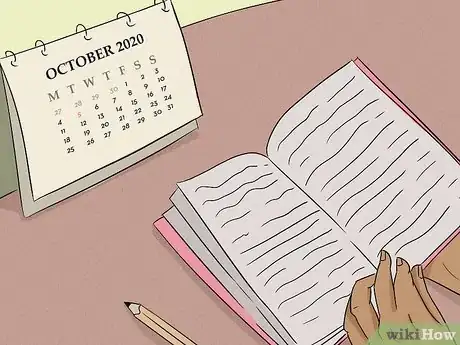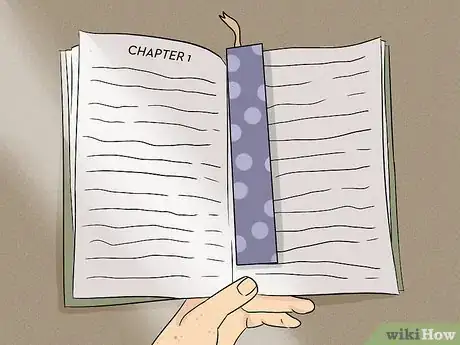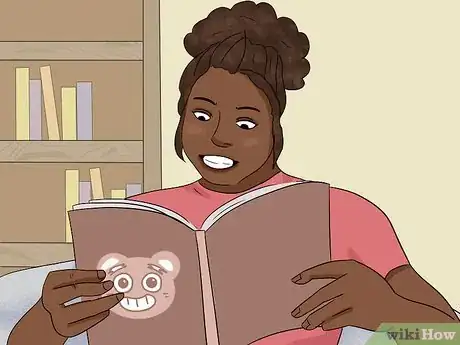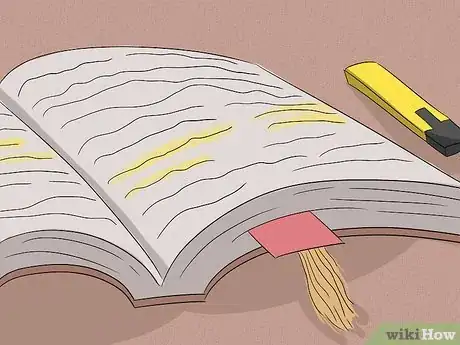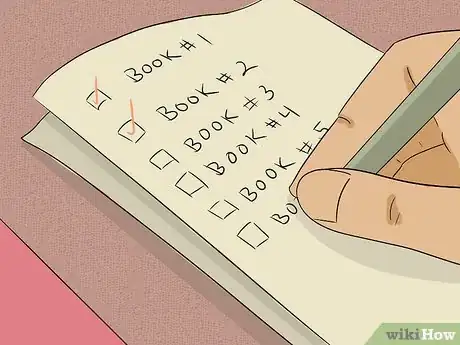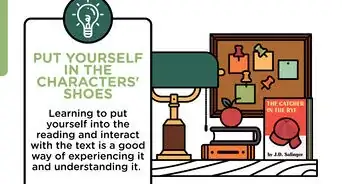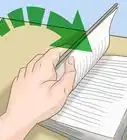This article was co-authored by Jake Adams. Jake Adams is an academic tutor and the owner of Simplifi EDU, a Santa Monica, California based online tutoring business offering learning resources and online tutors for academic subjects K-College, SAT & ACT prep, and college admissions applications. With over 14 years of professional tutoring experience, Jake is dedicated to providing his clients the very best online tutoring experience and access to a network of excellent undergraduate and graduate-level tutors from top colleges all over the nation. Jake holds a BS in International Business and Marketing from Pepperdine University.
This article has been viewed 108,563 times.
Reading multiple books concurrently isn't for everyone, but sometimes it's helpful to take in a lot of information quickly or to let your mind enjoy varied genres at once. Switching between books keeps each book fresh and it can be a good way to compare them. It can even help you decide what to read if you're not sure.
Steps
-
1Make time to read. If you cannot get through even one book at a time, starting several at once is only going to make the whole process slower. Even if you can only spend a few minutes per day reading, you can still switch on and off between different books.
-
2Select several books according to your interests and your reasons for reading them.
- The books may be related or unrelated, depending on your purpose. If you are researching a particular subject, they will probably be related. If you are reading for fun, the books may be any assortment you wish.
- Choose books that draw you in. It will be easier to come back to a book you enjoy.
Advertisement -
3Sample each book. You can read the beginnings (one at a time), or you can pre-read. Look at the table of contents, and read or skim the summaries, introductions, and prefaces.
-
4Start reading each book while your attention for it is fresh. Try to start the day you bring it home or the day you begin a project. Use your fresh interest to read a larger portion of a new book in the first sitting or sittings. Thoroughly engage with and commit to reading each book in turn. Reading more the first time will also give you a good head start.
- You need not start several books at the same time to read them concurrently. Instead, try laddering them, getting well into the first before starting the next.
-
5Scatter books around. Leave one on your nightstand, one by the breakfast table, and another in your bag. Read whichever book is nearby when you are there. Match the book to the focus or mood you usually have when you visit a certain place.
- Place one in your home bathroom in easy reach of the toilet, especially if it's nonfiction with a lot of short subtopics. You'll be surprised at how often you read in the bathroom. Don't put it where the shower will get it wet though and be careful if you read during soaking baths to have a towel handy to dry your hands while handling pages. You might want a short reading stand next to a bathtub.
-
6Mix books of different types and formats. Listen to an audio book in the car, keep a paperback or e-book in your purse, have e-books on your iPad, etc. Depending on your purpose, choose books of different subjects and difficulties, so that you'll have choices for different places and moods. Reading about different topics will help you keep straight which book is which.
- eBooks are convenient because they often let you look up definitions or conduct an internet search within the same screen.
- Your mind can cope well with associating different books being read within the same time period but in different places. So, have books for the bus or train to and from work, books for bedtime, books for the hammock afternoon, and books for moments when you need instructions, such as cookbooks.
- Keep in mind that reading a politically charged tome at bedtime will be more effort than a lightweight genre read. Another good reason for having several books on the go at once! Good bedtime choices include rereading old favorites - when you know how it ends, it's easier to set it down when you finally drowse.
-
7Have a time line in mind, even if it's not a firm or strict one. If no library or project due date is built into your reading choices, notice when you begin each book and pay attention to your progress. Use this awareness of time to keep yourself relatively focused.
-
8Don't ignore any book so long that you lose the story or forget where you were. The books you read concurrently must compete for your attention. If a book interests you much less than others, change your approach. Read that book separately. Read that book alongside others of a similar interest level. Or, consider dropping the book altogether.
-
9Make sure to mark your place when you stop. Read an entire chapter or section at a time whenever possible, or at least find a good stopping place. Reading an entire section in a sitting will help you keep continuity when you skip from book to book. Reading one or two shorter sections of a book per sitting can also help you understand difficult or complex writing better.
-
10Let your focus and preferences guide you. If you find yourself drawn into a book and feel like continuing for longer, go ahead. Read whichever book you are in the mood to read at a given moment.
-
11Get through a difficult book by using a fun book as a reward. Let yourself read the fun book for a while when you get through part of the difficult book.
-
12Take notes on key points as you go, or mark pages you will need to find again for a project.
-
13Try to read endings in longer sittings and spend less time in other books. Endings in fiction are often the most intense part of the story. In nonfiction, they usually contain summaries, conclusions, and other important information. Either way, try to read with more continuity near the end.
-
14Finish books. However many books you choose to read at a time, make sure to continue to read the important ones until you finish with them.
Community Q&A
-
QuestionHow many books is best to read at once?
 Community AnswerIt really depends on you. Some people can read five at a time, others have trouble keeping up with just one. If you're new to reading multiple books, start off with two at once and see how it goes, making sure you're actually absorbing the material. Don't focus too much on the quantity, just see what works for you, and make sure you're enjoying the reading.
Community AnswerIt really depends on you. Some people can read five at a time, others have trouble keeping up with just one. If you're new to reading multiple books, start off with two at once and see how it goes, making sure you're actually absorbing the material. Don't focus too much on the quantity, just see what works for you, and make sure you're enjoying the reading. -
QuestionCan I read two books at once if I place them side by side?
 Community AnswerI don't recommend it. If you tried, you'd probably get confused and fail to retain any of the information.
Community AnswerI don't recommend it. If you tried, you'd probably get confused and fail to retain any of the information. -
QuestionCan I read two book series at once?
 Community AnswerYes, if you want to. I usually alternate between two series at once - I read one or two books from the first series, then one or two from the second, then the next book in the first series, then the next in the second, etc.
Community AnswerYes, if you want to. I usually alternate between two series at once - I read one or two books from the first series, then one or two from the second, then the next book in the first series, then the next in the second, etc.
Warnings
- Particularly if reading multiple fiction books, choose ones that are set in different periods or have completely different themes, to avoid mixing up the characters and plot lines⧼thumbs_response⧽
- Be conscious of due dates and deadlines.⧼thumbs_response⧽
- Take precautions not to lose or damage library books.⧼thumbs_response⧽
Things You'll Need
- Various books
- Library card (optional)






